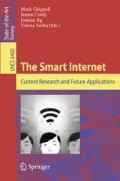Abstract
Key architectural elements of the web, namely, HTTP, URL and HTML enable a very simple user model of the web based on hyperlinks. While this model allows browser-based access to a wide array of online content and resources, the limitations in user experience provided in this interaction model are increasingly apparent. Two decades after the birth of the web, new technologies such as Rich Internet Application, AJAX, and Web 2.0 seek to improve web user interfaces, but in general their main benefit is to individual server sites. Little advancement has been made to advance the user model of the web at a macro level where the interaction is driven not by the server but by the user. This paper reviews the problems of the current internet in order to motivate the discussion of the smart internet that will occur in later chapters of this book.
Access this chapter
Tax calculation will be finalised at checkout
Purchases are for personal use only
Preview
Unable to display preview. Download preview PDF.
References
Hoffman, D.L., Novak, T.P., Venkatesh, A.: Has the Internet become indispensable? Comm. ACM 47(7), 37–42 (2004)
Allaire, J.: Macromedia Flash MX: A Next Generation Rich Client. Macromedia White Paper (2002)
O’Reilly, T.: What is Web 2.0? Design Patterns and Business Models for the Next Generation of Software. O’Reilly Media, Inc., Sebastopol (2005)
Ankolekar, A., Krotzsch, M., Tran, T., Vrandecic, D.: The two cultures: mashing up Web 2.0 and the semantic Web. In: Proceedings of the 16th International Conference on World Wide Web, WWW 2007, pp. 825–834. ACM, New York (2007)
Berners-Lee, T., Hendler, J., Lassila, O.: The Semantic Web. Scientific American 284, 34–43 (2001)
Garrett, J.J.: Ajax: A New Approach to Web Applications. Adaptive Path Inc., White Paper (2005)
Raman, T.V.: Toward 2w. Beyond Web 2.0. Comm. ACM 52(2), 52–59 (2009)
Dey, A.K.: Understanding and Using Context. Personal and Ubiquitous Computing 5(1), 4–7 (2001)
Berners-Lee, T., et al.: A Framework for Web Science. Foundations and Trends in Web Science 1(1), 1–134 (2006)
Baldoni, M., Baroglio, C., Henze, N.: Personalization for the Semantic Web. In: Proc. Reasoning Web, pp. 173–212 (2005)
Weiser, M., Brown, J.S.: The Coming Age of Calm Technology. Xerox PARC (October 1996)
Baddeley, A.D.: Is working memory still working? American Psychologist 56, 851–864 (2001)
Marsh, R.L., Cook, G.I., Hicks, J.L.: An analysis of prospective memory. In: Medin, D.L. (ed.) The Psychology of Learning and Motivation. Elsevier, Amsterdam (2006)
Whittaker, S., Sidner, C.: Email overload: exploring personal information management of email. In: Proceedings of ACM SIGCHI, pp. 276–283 (1996)
Hicks, J.L., Marsh, R.L., Cook, G.I.: Task interference in time-based, event-based, and dual intention prospective memory conditions. Journal of Memory and Language 53, 430–444 (2005)
Morris, D., Ringel Morris, M., Venolia, G.: SearchBar: a search-centric web history for task resumption and information re-finding. In: Proceeding of the Twenty-Sixth Annual SIGCHI Conference on Human Factors in Computing Systems, CHI 2008, Florence, Italy, April 05-10, pp. 1207–1216. ACM, New York (2008)
Kahneman, D.: Attention and Effort, p. 246. Prentice Hall, Englewood Cliffs (1973)
Neisser, U.: Selective Reading: A method for the study of visual attention. In: Nineteenth International Congress of Psychology, London (1969)
Roda, C., Thomas, J.: Attention aware systems: theory, application, and research agenda. Comp. Hum. Behav. 22(4), 557–587 (2006)
Author information
Authors and Affiliations
Editor information
Editors and Affiliations
Rights and permissions
Copyright information
© 2010 Springer-Verlag Berlin Heidelberg
About this chapter
Cite this chapter
Ng, J.W., Chignell, M., Cordy, J.R., Yesha, Y. (2010). Motivation. In: Chignell, M., Cordy, J., Ng, J., Yesha, Y. (eds) The Smart Internet. Lecture Notes in Computer Science, vol 6400. Springer, Berlin, Heidelberg. https://doi.org/10.1007/978-3-642-16599-3_1
Download citation
DOI: https://doi.org/10.1007/978-3-642-16599-3_1
Publisher Name: Springer, Berlin, Heidelberg
Print ISBN: 978-3-642-16598-6
Online ISBN: 978-3-642-16599-3
eBook Packages: Computer ScienceComputer Science (R0)

